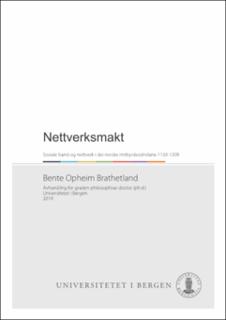| dc.description.abstract | This thesis explores social ties and networks among the elite in 12th and 13th century Norway. The purpose of the study is to address the question of what caused the high level of conflicts from 1130 to 1208, a time period known as the Civil Wars. These wars are characterized by rivalry between contesting royal pretenders, supported by various elite groups. A mapping of the various, and changing, networks of the elite is assumed to explain the power base of the royal contenders and expose the interests at stake. The study explore these questions through a prosopographical investigation of royal sagas from the 13th century. This has resulted in a digital prosopography (SagaFolk) which holds biographical information of over 1000 people mentioned in the sagas and the relationship between them. This data has been further discussed using theoretical concepts derived from field theory (Bourdieu) and network analysis theory. The thesis explores the networks of the Norwegian elite through a chronological description of how royal pretenders established and maintained power from the outbreak of the wars in 1130 to the peace agreement reached in 1208. The study suggests that the wars broke out as a reaction from a group within the established elite to limitations on their political involvement. This elite group was composed by a close- knit network of local magnates, located for the most part in Western Norway and the Orkneys. This network proved quite stable over time, and continued to dominate through the establishment of a coalition of magnates, ruling on behalf of the young sons of Harald Gille, until they came of age at the beginning of the 1150s. At this point, war broke out again, as a result of rivalry between the young kings trying to establish their independent networks. Throughout the 1160s and 1170s the lines of division sharpened, fumed by an extensive marital strategy and blood feud. The involvement of the Catholic church is highlighted, as it did not only represent a strong ally to one party in the conflict in particular, but also because its allegiance to the reformed papacy during the schism (1159), influenced relations to Denmark. At the turn of the century, relations to Rome continued to dominate the scene, as the two contesting parties in the war, the birkebeinar and the baglar, sought allies among contesting parties in Sweden, which in turn were connected to magnate networks in Denmark, and caused involvement from Rome. At a general level, this thesis is a contribution to the field of prosopography and network studies in Norway, and contributes to the study of the civil wars, by highlighting the cross-national dimensions of politics and the role of the Catholic church. | en_US |
